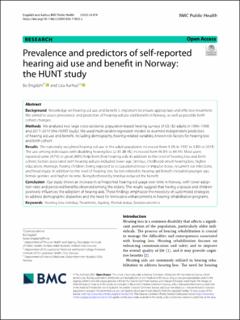| dc.description.abstract | Background Knowledge on hearing aid use and benefit is important to ensure appropriate and effective treatment. We aimed to assess prevalence and predictors of hearing aid use and benefit in Norway, as well as possible birth cohort changes. Methods We analyzed two large cross-sectional, population-based hearing surveys of 63,182 adults in 1996–1998 and 2017–2019 (the HUNT study). We used multivariable regression models to examine independent predictors of hearing aid use and benefit, including demography, hearing-related variables, known risk factors for hearing loss and birth cohort. Results The nationally weighted hearing aid use in the adult population increased from 4.2% in 1997 to 5.8% in 2018. The use among individuals with disabling hearing loss (≥ 35 dB HL) increased from 46.3% to 64.4%. Most users reported some (47%) or great (48%) help from their hearing aids. In addition to the level of hearing loss and birth cohort, factors associated with hearing aid use included lower age, tinnitus, childhood-onset hearing loss, higher education, marriage, having children, being exposed to occupational noise or impulse noise, recurrent ear infections, and head injury. In addition to the level of hearing loss, factors related to hearing aid benefit included younger age, female gender, and higher income. Being bothered by tinnitus reduced the benefit. Conclusion Our study shows an increase in self-reported hearing aid usage over time in Norway, with lower adoption rates and perceived benefits observed among the elderly. The results suggest that having a spouse and children positively influences the adoption of hearing aids. These findings emphasize the necessity of customized strategies to address demographic disparities and the need for innovative enhancements in hearing rehabilitation programs. | |
